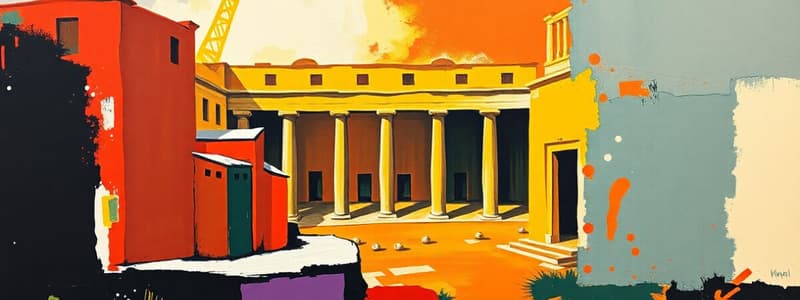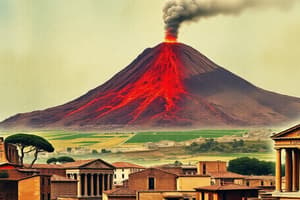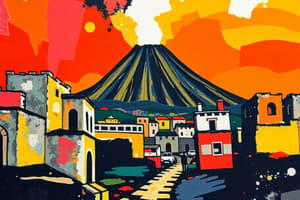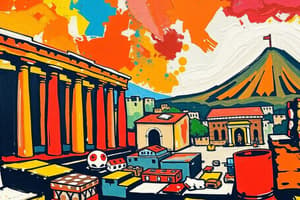Podcast
Questions and Answers
What architectural feature is present in the atrium of Herculaneum?
What architectural feature is present in the atrium of Herculaneum?
- Ionic columns
- Lystoed columns (correct)
- Corinthian columns
- Doric columns
What significant discovery was made in the palaestra?
What significant discovery was made in the palaestra?
- A network of thermal baths
- Carbonized tree trunks (correct)
- A statue of Hercules
- A mosaic floor
What shape did the fountain at the center of the palaestra resemble?
What shape did the fountain at the center of the palaestra resemble?
- A nymph
- A Hydra (correct)
- A phoenix
- A dolphin
Which street served as the main thoroughfare of Herculaneum?
Which street served as the main thoroughfare of Herculaneum?
What type of establishment is described as thermopolia in Herculaneum?
What type of establishment is described as thermopolia in Herculaneum?
What significant geographic feature contributed to Herculaneum's destruction during the eruption?
What significant geographic feature contributed to Herculaneum's destruction during the eruption?
Which feature of Herculaneum offers insight into its well-preserved buildings?
Which feature of Herculaneum offers insight into its well-preserved buildings?
What was the primary architectural layout of Herculaneum?
What was the primary architectural layout of Herculaneum?
What is significant about the Decumanus Maximus in Herculaneum?
What is significant about the Decumanus Maximus in Herculaneum?
What role did Marcus Nonius Balbus have in the history of Herculaneum?
What role did Marcus Nonius Balbus have in the history of Herculaneum?
Which discovery was made about the health of the people of Herculaneum?
Which discovery was made about the health of the people of Herculaneum?
Why is the ancient port area significant in understanding Herculaneum's topography changes?
Why is the ancient port area significant in understanding Herculaneum's topography changes?
What does the line of doors located near the ancient port represent?
What does the line of doors located near the ancient port represent?
Flashcards
Lystoed columns
Lystoed columns
Columns that are slightly angled inward, creating a slight inward curve. This design was used in the atrium of Herculaneum.
Palaestra
Palaestra
An exercise yard, often found in Roman cities. In Herculaneum, the palaestra was partially buried by the volcanic eruption.
Thermopolia
Thermopolia
Fast food establishments in ancient Roman cities. These were shops along the streets serving hot and cold ready-made meals.
Decumanus Maximus
Decumanus Maximus
Signup and view all the flashcards
Public center
Public center
Signup and view all the flashcards
Herculaneum
Herculaneum
Signup and view all the flashcards
Pyroclastic Surge
Pyroclastic Surge
Signup and view all the flashcards
Carbonized Wooden Doors & Furniture
Carbonized Wooden Doors & Furniture
Signup and view all the flashcards
Boat Sheds
Boat Sheds
Signup and view all the flashcards
Marcus Nonius Balbus
Marcus Nonius Balbus
Signup and view all the flashcards
House of the Telus Relief
House of the Telus Relief
Signup and view all the flashcards
Study Notes
Herculaneum: Buried City
- Herculaneum, like Pompeii, was destroyed by the eruption of Mount Vesuvius in 79 AD.
- Herculaneum is much smaller than Pompeii and receives fewer visitors.
- Buildings in Herculaneum are exceptionally well-preserved, with some still containing carbonized wooden doors and furniture.
- Before the eruption, Herculaneum was located on a promontory jutting into the bay, with water reaching the base of its city walls.
- The eruption caused a series of pyroclastic surges that buried the city under 20 meters of volcanic debris and pushed the shoreline 400 meters further out.
- The debris hardened into a rock-like consistency, making excavation extremely challenging.
- Only about 25% of the site has been uncovered to date.
- Herculaneum, like many Roman cities, was laid out on a grid plan.
- The most important street, the Decumanus Maximus, is located at the back of the excavated area.
- A series of narrower streets called "cardi" cross the Decumanus Maximus.
- The ancient port area, recently paved over, shows the dramatic changes in topography caused by Vesuvius.
- A line of doors on the left of the paved area marks the boat sheds.
- These low arcades faced the beach and sea, likely used for storage.
- On the night of the eruption, approximately 300 people sought shelter inside the boat sheds and were instantly killed by a pyroclastic surge.
- Replicas of their skeletons are inside the boat sheds, though not visible from this vantage point.
- Forensic anthropologists studied the bones, revealing that the people of Herculaneum were remarkably healthy.
- They had few cavities, consumed plenty of fish, and were taller than the 20th-century Neapolitan population.
- Located above the boat sheds is the funerary altar and a replica of the statue commemorating Marcus Nonius Balbus, Herculaneum's most distinguished citizen.
- He died nearly a century before the eruption and was cremated just outside the walls.
- Balbus was a praetor and provincial governor, who retired to Herculaneum and invested his wealth in the town.
- He built the Basilica and rebuilt the town's walls.
- Numerous Herculaneans were descendants of his freedmen and adopted his name.
- Located above the Terrace of Marcus Nonius Balbus is the house of the Telus Relief, named for a relief depicting the Greek hero Telus.
- This opulent residence may have been built for Balbus or one of his wealthy contemporaries.
- The atrium features lystoed columns, a newly rebuilt roof, and marble Ulae – decorative discs that spun and waved in the breeze.
- In a partially buried area known as the palaestra (an exercise yard), excavators found carbonized tree trunks swept into a corner by the eruption's force.
- A tunnel allows access to a network of tunnels created by Bourbon excavators in the 18th century.
- Among other discoveries, these tunnels uncovered a remarkable fountain at the center of the palaestra.
- The fountain was shaped like the Hydra, likely referencing Hercules, after whom Herculaneum was named.
- Walking up Cardo 5 towards the Decumanus Maximus, several well-preserved thermopolia – fast food establishments – can be found.
- One such thermopolia has a marble counter where patrons were served.
- The Decumanus Maximus, Herculaneum's main street, was a bustling thoroughfare with a portico lined by shops.
- Some buildings have reconstructed second stories with carbonized wooden beams set back in place.
- The town's public center was likely located around the arch at the far end of the Decumanus Maximus.
Studying That Suits You
Use AI to generate personalized quizzes and flashcards to suit your learning preferences.





